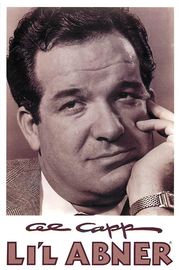Daisy Mae Yokum (Née Scraggs)
Character
Daisy Mae was hopelessly in love with Dogpatch's most prominent resident throughout the entire 43-year run of Al Capp's comic strip. During most of the epic, the impossibly dense Abner exhibited little romantic interest in her voluptuous charms (much of it visible daily thanks to her famous polka-dot peasant blouse and cropped skirt). In 1952, Abner reluctantly proposed to Daisy to emulate the engagement of his comic strip "ideel," Fearless Fosdick. Fosdick's own wedding to longtime fiancée Prudence Pimpleton turned out to be a dream — but Abner and Daisy's ceremony, performed by Marryin' Sam, was permanent. Abner and Daisy Mae's nuptials were a major source of media attention, landing them on the aforementioned cover of Life magazine's March 31, 1952, issue. Once married, Abner became relatively domesticated. Like Mammy Yokum and the other "wimmenfolk" in Dogpatch, Daisy Mae did all the work, domestic and otherwise — while the useless menfolk generally did nothing whatsoever.
Subject ID: 67328
MoreDaisy Mae was hopelessly in love with Dogpatch's most prominent resident throughout the entire 43-year run of Al Capp's comic strip. During most of the epic, the impossibly dense Abner exhibited little romantic interest in her voluptuous charms (much of it visible daily thanks to her famous polka-dot peasant blouse and cropped skirt). In 1952, Abner reluctantly proposed to Daisy to emulate the engagement of his comic strip "ideel," Fearless Fosdick. Fosdick's own wedding to longtime fiancée Prudence Pimpleton turned out to be a dream — but Abner and Daisy's ceremony, performed by Marryin' Sam, was permanent. Abner and Daisy Mae's nuptials were a major source of media attention, landing them on the aforementioned cover of Life magazine's March 31, 1952, issue. Once married, Abner became relatively domesticated. Like Mammy Yokum and the other "wimmenfolk" in Dogpatch, Daisy Mae did all the work, domestic and otherwise — while the useless menfolk generally did nothing whatsoever.
Subject ID: 67328
Subject ID: 67328

